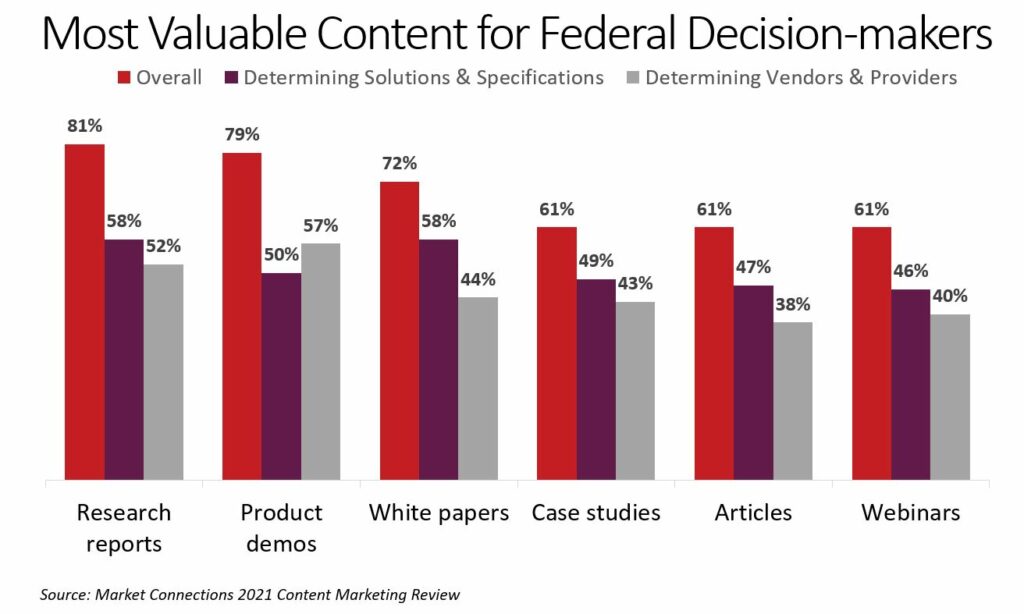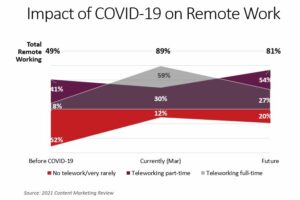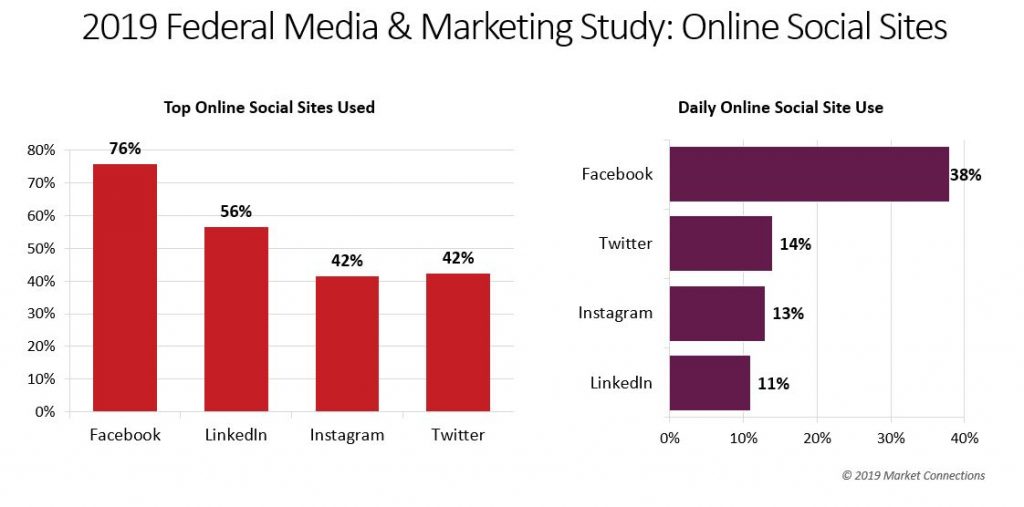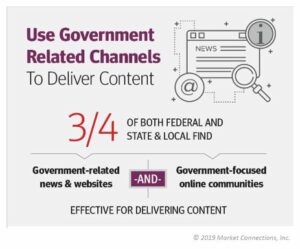Content Marketing
By Susan Rose, Senior Director, Content & Insights, GovExec
 Trust. It’s a word nearly everyone uses when talking about marketing and selling, especially in the federal market. For good reason: trust is everything. You can have the best product or service in the industry, but if federal prospects don’t trust you, they won’t buy it.
Trust. It’s a word nearly everyone uses when talking about marketing and selling, especially in the federal market. For good reason: trust is everything. You can have the best product or service in the industry, but if federal prospects don’t trust you, they won’t buy it.
The best way to build trust is with face-to-face interactions. But to have those, you must get in the door and why would someone invite you in if they don’t trust you yet?
What can you do? If you look at social media or do an internet search on any topic, you will find a plethora of research reports, webinars, blogs, case studies, articles, and podcasts — for good reason: these types of content build trust.
Trust and the Buyer’s Journey
When customers have problems they need to solve, they start looking for answers. Sales and marketing functions exist to answer those questions. But when, where, and how we answer those questions depends on where prospects are in their buyer’s journey. Someone who doesn’t know what the problem is has different needs than someone who is ready to sign a contract. Trust at each stage is important, no doubt about it.
The challenge is when you need to build that trust with someone you’ve never met who is looking for answers quietly from their office.
These people may be at the top of the sales funnel, in the “awareness” stage. They’re searching the internet to educate themselves, find relevant resources and insight, and examine research data. Or they may be in the “evaluation” stage, where they have an idea of what type of solution they need and are looking for those vendors they believe can provide it.
This is your chance to influence their decision and build trust by providing educational content full of relevant insights.

Content that Builds Trust
I’m a firm believer that delivering what the audience wants in the format they want it will always go far toward building trust. You can break down trust-building content into two parts: the information it contains and the format. I want to focus on the information.
The Market Connections 2021 Content Marketing Review surveyed public sector buyers about their content preferences. Overall, 81% of Federal buyers find research reports the most valuable content.
That’s because research reports educate rather than sell. It’s not about benefits and features of a specific product, it’s about what is happening in the industry and the world, how that impacts the prospect’s big goals, and what they need to consider going forward.
In fact, all the top valuable types of content center around education and sharing expertise. Federal buyers want to know that you know the industry inside and out and are willing to share that knowledge.
What You Can Do Now
To build trust with content, the information you are sharing needs to focus on value. That means it is truthful, authentic, and helpful.
It focuses on the problem, possibly from an angle the audience hasn’t thought about. Or perhaps it educates them about a new way of approaching a problem.
Whatever you are sharing, keep the buyer’s needs in mind. It’s always about them.
Learn more:
 In the late 1800s French chemist Henry Louis Le Chatelier described a system of shocks and counter-shocks that eventually settles into an equilibrium at a level that is neither where it started nor where it might eventually go. This idea, that any stable system encountering external forces pushing back and forth to establish a new level of normal, can easily describe the world in which we all now have to make business decisions. While 2021 will not be like 2020, it won’t be like the stable environment of 2019 either. It will likely be somewhere in between, but who really knows where?
In the late 1800s French chemist Henry Louis Le Chatelier described a system of shocks and counter-shocks that eventually settles into an equilibrium at a level that is neither where it started nor where it might eventually go. This idea, that any stable system encountering external forces pushing back and forth to establish a new level of normal, can easily describe the world in which we all now have to make business decisions. While 2021 will not be like 2020, it won’t be like the stable environment of 2019 either. It will likely be somewhere in between, but who really knows where?
As public sector marketers, we have had to reconsider some tried and true ways to reach and interact with our target audiences. Large tradeshows and meeting with your customers in-office or at lunch are unpredictable or uncertain, replaced, for now with virtual events and video conferencing.
Government customers are racing to make heavy investments into technology and supply chain as they wrestle with the need to respond to the crisis and create safe work environments that respond to the pushes and pulls of a variety of shocks to their systems. Vendors and suppliers have a unique opportunity to educate and support their customers in a broad variety of ways, challenging budgets, workflows and internal capabilities.
Revisiting Your Post-Quarantine Marketing Strategy
As Le Chatelier’s principle dictates, as federal marketers we must continue to fine-tune strategies in a world that is not in as much upheaval as last year, but we must be wary of reverting to the way things were done before. New opportunities abound, but as we have learned from past sailors who began to sail off the maps of old, there may be dragons ahead!
 Federal employees will continue to work from home. With eight in ten federal employees saying they expect to work remotely at least part-time (According to the 2021 Content Marketing Review), considerations about how and where they go for information are important. Purchasing radio time is one example of where marketers may want to refine their strategy. While drive-time radio listenership may drop, listenership throughout the day has grown.
Federal employees will continue to work from home. With eight in ten federal employees saying they expect to work remotely at least part-time (According to the 2021 Content Marketing Review), considerations about how and where they go for information are important. Purchasing radio time is one example of where marketers may want to refine their strategy. While drive-time radio listenership may drop, listenership throughout the day has grown.
With more government employees working from home, barriers have been removed to accessing social media, especially on their personal devices (whether mobile, tablet or laptop), which may have not historically been allowed in their secure offices.
Vaccine mandates may open up some in-person events, but the size of event and event safety protocols — combined with the need to provide simultaneous virtual streaming — may prevent these events from being economically feasible for many marketers. Agencies likely will continue to have some level of travel restrictions and/or limit staff attending. Leadership may realize, from experience through the pandemic, that they can still access the information without the need to incur travel costs.
Get Insights to Refine your Federal Marketing Strategy
It’s important to know your customers’ preferences to review, edit or fine-tune your current marketing strategy to ensure ROI. With the shock to the equilibrium in 2020, a new environment is apparent in 2021. Federal marketers cannot just go back to how things were done before, nor can they just repeat 2020 efforts.
For over ten years, Market Connections has taken the pulse of the federal market’s media and marketing preferences to support our government contracting community with data and insights that can inform those strategic decisions. From digital to print media, social media, television, radio and podcasts to event and webinar preference and attendance, it is important now, more than ever, to check your strategy against the data provided by the study.
Learn more and purchase: https://www.marketconnectionsinc.com/fmms2021event/
B2G marketers often reach out to us for data and insights on how to strengthen their business proposition, get in front of their customers and help their sales team with lead generation. As a market research company, we conduct interviews, focus groups and surveys to help our government contracting customers refine their strategies for a stronger return on investment.
Who Are You Targeting?
 The first request we usually get is “I only want to hear from the C-suite,” with the assumption that these individuals are THE key drivers of any procurement.
The first request we usually get is “I only want to hear from the C-suite,” with the assumption that these individuals are THE key drivers of any procurement.
Our follow up question is, who sits around the boardroom table influencing those (C-suite) decisions? Who is writing the recommendation memo? Chief officers do not make decisions in a vacuum, but instead surround themselves with their staff to help understand the challenges of their work, gather feedback on their perceptions and experiences with vendors and provide recommendations and/shortlist prospective contractors. The Federal IT Personas Study focuses on those folks around the table with top execs who influence and advise throughout the procurement process.
Have you identified those trusted advisors and influencers and targeted them as well? Do you understand their motivations and preferences? A procurement officer’s issues will differ vastly than a technical expert’s or a program manager’s. Understanding what is important in their decision-making, what motivates them at work, how they prefer to get information, etc., can help you develop the right strategy that educates, influences and creates trust with your targets.
What Information Are You Providing?
Once you have identified WHO you want to talk to, the next step is WHAT you want to provide them with. What works with corporate or B2C audiences does not necessarily translate in the public sector market.
First, your content needs to educate your audience. The Content Marketing Review revealed that across the public sector landscape, IT influencers and decision makers are hungry for content containing data and research, as well as examples of past experiences and case studies. Whether federal, state and local, or education, research reports, white papers, case studies and product demos top the list of types of content. Regardless of whether they are starting to develop their requirements or finalizing their selection of vendor, understanding what your audience is looking for can help you become a trusted vendor.
Narrowing down the WHAT helps focus your resources and budget dollars. What content gives you the most bang for your buck? Where will you get the biggest ROI? Having those insights, your content creation strategy becomes easier to assemble and you can focus on the next question.
Where Is Your Audience Going for Information?
The final piece of the puzzle for public sector marketers once they’ve created great content is WHERE to place it. We remind our clients that creating great content is not a one and done scenario. One needs to share that content with their audiences where they already are, including speaking opportunities at events, webinars, in earned and sponsored media, social media, or other platforms.
Going where your customer already is, prompts the questions, “Where are they going for information, what sources do they trust, and how can you get and stay in front of them?”
Instead of throwing spaghetti on the wall and hoping it will stick, this information is already out there for you. The Federal Media & Marketing Study looks at the media consumption and marketing tactics preferred among federal audiences. It takes into consideration all types of media including print, online, television, radio, and other channels such as social media, podcasts, events and webinars. Based on a survey to thousands of federal respondents, the database provides findings that can be drilled down to detailed agency types, agencies, product categories, role at the agency, location or other demographics.
Final Thought
With answers to the questions “WHO, WHAT and WHERE,” B2G marketers can create a strategy for understanding their target audiences and provide them the information they are looking for in the places they are looking for it. Syndicated studies from Market Connections or further investments in custom research can provide those answers and insights for agency or target-based marketing, a small investment that can increase the ROI of everyone’s marketing efforts.
Want to learn more about research in the public sector? Contact us.
For more information about the following studies:
On Tailoring Content Marketing to Target Agencies
Following the Content Marketing Review release, we reached out to our strategic partner, Government Marketing University’s expert COO and co-founder, Stephanie Geiger to share some tactical advice for content creation for government marketers looking to reach audiences with agency-based marketing.
Watch the interview video or read the Q&A below for more details.
AH: Greetings everybody and welcome to the latest update after our Content Marketing Review (here just a couple of weeks ago), my name is Aaron Heffron and I am the president of MC and we’ve been doing these video follow-ups with some leading marketers around the industry to give us a little color and context about the research we did recently, hopefully many of you already listened in to that presentation, and today I welcome Stephanie Geiger who is COO and cofounder of Government Marketing University. Welcome, Stephanie.
SG: Thanks, Aaron. Hey, how are you?
AH: Doing just fine. So, thank you for joining. Government Marketing University has been a partner of ours, for I can’t even remember how long now… it’s been many years.
SG: Almost since the beginning.
AH: Almost since the beginning, yes. It’s great. You guys do a lot of great things out for the marketing community within the public sector. Before we get started, can you tell me a little bit about what Government Marketing University is doing?
SG: Sure, yeah. So, we’re basically a marketplace of knowledge. What we’ve been doing since we launched back in 2015 is to bring together a place where we have all sorts of different experts from across the public sector, industry, current and former government, thought leaders, media – all sorts of folks from across the community – in order to really help provide education, training, and opportunities to network and connect with individuals and peers.
We’ve specifically been partnering with Market Connections since we got launched to help to bring surveys and focus groups and other valuable information and gathering different types of content and statistics for our marketers to really help them and empower them throughout their entire career and journey within the government marketing space. We have a couple of things coming up together. We’re excited to launch our visionary series that’s going to be coming to market soon. We’re going to be interviewing some various experts within the industry and bringing some snippets of educational content for our marketers.
AH: Yeah, I look forward to those. Those are great conversations we had with some senior marketers in the space. I’m excited about that coming out. But one of the things I know that has come up in those conversations has been the idea of account or agency-based marketing as it’s sometimes called. Tell me how that connects to the content marketing, how do those go hand and glove with each other?
SG: Sure, so I think a lot of marketers freak out when they think, “How can I do agency-based marketing when it comes to content? I’m going to have to have 15 different pieces right, so I can market to each of the various agencies and their specific missions that I’m trying to craft messages to.” But the way that I approach agency-based marketing is, if you have smaller budgets, limited bandwidth, really zero in on one or two agencies that you feel that might be a little bit lower hanging fruit, you feel might be able to make some initial traction in, and instead of creating multiple assets, start to pick one that can serve as kind of a multi-purpose asset.
So, think about a one-minute white paper, that you can flip out some potential snippets to use on social media or you’re tagging those key influencers or decision-makers within that agency, or maybe do a podcast, right? Where you can pull out some of that content and flip it into a blog post. Capitalizing on that time you have with your internal subject matter experts to elicit that information, all those great juicy nuggets, and then being able to use that in a multi-purpose way, I feel like it’s really the best use of your time in order to start making headway. Start small and then make impact and figure out how you can continue to grow that. Repeatable process-driven marketing is always a great way to approach agency-based marketing.
AH: So, you’re saying, “Create this repository or pool of information, and rather than recreating that pool of information for each agency you want to go after, you’re cherry-picking within that?” Am I accurately laying that out?
SG: Yeah, absolutely. So, if you’re focusing on one particular agency (right?), getting to know them, really zeroing in on them… instead of trying to do agency-based marketing across five to seven targets (right?), zero in on one to two and create that repository that you can draw from in order to make sure you’re creating those customized assets.
AH: That’s interesting. We hear a lot, and that bears out in the Content Marketing Review, that the long-form written content is invaluable to them. Everything is in one place – you have everything there. You’re talking (a little bit), kind of shorter form content. So, what are those couple things you need to think about in that shorter form content that can still have some impact?
SG: I think, with any of this, we know that there are still audiences that like that longer-form content. So, it’s really understanding the consumption needs and mapping to those, as far as the type of content we push out – I think, like a technical role (right?), who always wants a 4-6 page white paper, but then somebody from a business perspective, where maybe an infographic or these one-minute white papers like I talked about, which are kind of a hybrid between some technical specs that you see in a white paper and a more of an “infographic-y” feel with some statistics – so we like to zero in on the opportunity of mapping the need and the content piece.
So, not just writing a long-form piece of content because you think it’s going to sound great, and your subject matter expert was really happy to share those delicious insights with you but figuring out what it is that is going to actually help ensure that the piece gets read. And we know historically that shorter form content is starting to become much more prominent because of COVID and shorter attention spans. So, as you’re looking for ways to draw the attention, find ways to have teaser copy as you’re posting it out on your social media or find ways to create something that might have traditionally been in a longer form, that can be represented in maybe a more of a graphical or shorter form capacity.
AH: I’ve heard from some of our clients that some of the most effective content they have isn’t necessarily have a lot of bells and whistles to it, it’s that it’s as targeted to that particular answering to that particular question as they can, because they’re seeking that information. It could just be a guy or a woman with a whiteboard behind them sketching something out, but it’s exactly asking their question. So, it’s important to really know what those questions are and what the needs are out there.
SG: Absolutely. Use cases are great (right?) because you can create a couple of use cases that map to your core values and capabilities that can be a multi-agency mechanism and support. So, if you think you have something that you can apply widely across civilian agencies, we’ll come up with that use case and find some different types of consumable opportunities for that (right?). You can have a short video like you mentioned, you can have a podcast Q&A, have some versatility (right?) in the types of content that will still allow you to reach that diverse influencer and decision-maker audience.
AH: So, keeping this short and to the point – make it consumer-friendly, as we’re talking about – last parting words… What’s one bit of tactical advice that you would give folks as they’re looking at their content plan or trying to figure out how to get their content, what’s that one tactical takeaway you can give?
SG: Well, I mean… I think… not to keep going back to COVID, but if COVID has taught us anything it’s to be agile. Work to identify those key milestones or goals within your content marketing strategy but then allow for some flexibility to be able to map to what’s going on in the market. You think about the Technology Modernization Fund (TMF) or the new executive order on cybersecurity. You need to allow some flexibility so you can respond and allow yourself some opportunity for timely responses. So that you’re ensuring that you have your core pieces intact every year, but you have some flexibility to be responsive and timely in a market.
AH: Well, that’s good advice, being agile and flexible. You can never go wrong in having that for you. So, thank you to Stephanie. Thanks for taking the time today, appreciate it. I hope you enjoy the rest of your day and get out into the sunshine today. So, it’s wonderful having you as a partner and glad to have you today.
SG: Appreciate you, thank you!
ABOUT THE CONTENT MARKETING REVIEW
Our biennial study surveys government IT decision-makers to understand what types of marketing assets they find most useful and influential during the buying process, what information the content should contain, and where they are going to look for content. Over the years, the audience has expanded from federal decision-makers to include the full gamut of the public sector market, including state and local and education.
Whether it’s blogs, white papers, videos, podcasts, or reports: public sector decision-makers turn to thought-leading sources like these to inform their buying decisions, learn about new technologies, and gauge vendors. Results from our study provide insights followed by best practices for public sector marketers looking to create content marketing to reach and influence their target FED and SLED customers and prospects.
Learn more and download the report and on-demand video.
All government marketers understand the importance of including content in their marketing strategy, but winning government contractors make sure that their content contains the key features their audience is looking for.
According to Content Marketing Review: Federal and Beyond, this includes data and research to support their position, product specifications and examples of past performance. The trouble is – these specific pieces can often be the densest and most un-user-friendly bits of information you have!
Using Subject Matter Experts
How can you highlight these features in a way that is easily comprehensible and relatable to your target audience (and, frankly, a little more interesting)? Use your subject matter experts (SMEs). Your SMEs can not only focus your materials on a particular process, technology, niche within a technology, or a particular agency, they can help influence RFPs (request for proposals) or those shaping them.
Government marketing expert, Mark Amtower, agrees. In a video for his YouTube channel, Amtower Raw, Mark discusses the importance and value of using SMEs to win government business.
Watch the full video here:
“These companies are more likely to win business because in the RFPs, and while the contracting officers are looking to build the RFPs, they’re looking for people out there who understand, write, and talk about this stuff. The more visible your SME is, the more they’re sharing – particularly through your website, through LinkedIn and other social platforms, through speaking or doing articles for trade publications – the more visible they are that way, the more they’re helping the contracting officer shape their RFP directly and indirectly.” He continues on by saying, “so you don’t have to be put it right in front of them, but you have to put it where they can find it. Building the platform that way and shaping it gives you consciously or unconsciously a preferred position. People like dealing with people who are thought leaders or subject matter experts.”
Industry vs. Government Thought Leaders
Thought leaders can reside in industry or government. At least one in five respondents to the Market Connections’ study expect their content to contain insights from thought leaders. Federal decision-makers look more towards industry thought leaders, while those in state and local indicated their preference for insights from either industry or government thought leaders (sometimes both).
The key lesson is this: when creating those valuable pieces of content, include the key features your audience is looking for. Subject matter experts can help provide key information around product specifications, data and research and even provide past performance examples in a friendly way by showcasing their expertise. Share that content across your website, social media, and trusted trade publications (including online, podcasts, video, print, and radio) to help educate your audience, highlight your position, and even shape an RFP.
Learn more:
Download the 2019 Content Marketing Review Study infographics and presentation.
Join us on Thursday, May 20 as we reveal results from the 2021 Content Marketing Review: Reaching the Public Sector which will highlight findings encompassing the full FED and SLED market.
 Increasingly over the past few years, federal marketers have been asked by senior management to prove a positive return on investment on their marketing dollars. In today’s altered landscape, marketers are also faced with having to account for their target audience’s changing work environment and agency priorities. With this in mind, what questions should federal marketers ask before their strategies are developed and investments made?
Increasingly over the past few years, federal marketers have been asked by senior management to prove a positive return on investment on their marketing dollars. In today’s altered landscape, marketers are also faced with having to account for their target audience’s changing work environment and agency priorities. With this in mind, what questions should federal marketers ask before their strategies are developed and investments made?
Who Are You Targeting?
Earlier this year, our President, Aaron Heffron wrote about the difference between expanding versus exploring when it comes to your customer base. Regardless of whether you are looking to expand your customer base to new agencies or looking to build deeper relationships with the agency you are currently working with, it’s important to know your customer’s preferences, learning styles, preferred communication styles and the challenges they are facing.
Agency-based marketing (and even people-based marketing) are terms we hear more and more. Sales and marketing need to work together to develop their buying personas to understand who and how to best approach the marketplace. Using data versus anecdotes will yield the best results. Whether you develop your own personas or look to the Federal IT (FIT) Persona Study, knowing your customer will increase the ROI on any marketing effort.
Will Your Message Resonate?
Before launching any new campaign (especially grand (read: expensive) ones), it’s a good idea to include message testing research in the beginning to create a baseline and ultimately demonstrate the ROI from beginning to end. Pre-testing your messaging provides information on your prospects’ awareness of your brand and a read on how well your message fits within that brand perception. Returning to a similar audience to test the change in awareness and perceptions allows for dynamic message refinements and adjustments to ensure resonance and relevance with your audience. Agency priorities can change swiftly, and contractors often need to be able to change with the tides.
How Should It Be Delivered?
Once you have an idea about what you want to say, how is it best delivered? Depending on whether you want to create awareness or influence buying decisions, your content may need to take different formats.
Public sector marketers know content is king, but you will need to consider your target audience’s learning preferences. Do they tend to read, listen, or watch content to learn more about the services or products? Are they looking for past examples of how new ideas have worked or seeking knowledge (and reassurances) from industry or government thought leaders?
Over the years, we periodically dove into the world of content marketing. Our 2017 Federal Content Marketing Review highlighted what content federal audiences want during the different steps of the buying process. The 2019 Content Marketing Review introduced state and local audiences into the mix. In 2021, we will reprise the study and assess the K-12 and higher-ed markets and review how COVID-19 may have impacted preferences from years past. (Register for the 2021 Content Marketing Review: Reaching the Public Sector)
Where Should You Place It?
Whether earned or paid, you want to ensure the content created is reaching the right eyeballs. In times of tightening budgets, every marketing and advertising dollar spent needs to be well-thought out. Targeting matters. Some media channels can be more effective for a general federal audience, while others can most efficiently reach an agency, agency-type, or professionals with a specific job function or within a purchase category. The Federal Media and Marketing Study provides you data about their media usage across print, broadcast, social and digital sources.
This is especially important in years where their habits may have changed. Various factors are challenging conventional wisdom. With more federal employees teleworking, things such as radio advertising, print advertising and social media use have been deeply affected. Having the data to back your advertising decision will help you decide where to invest your advertising and marketing dollars.
Final Thought
Data-enabled informed strategic decisions can help maximize ROI. Market Connections has spent the past 25 years gathering data and insights from public sector influencers and decision-makers to support our government contracting clients in informing their strategic planning, validating their marketing spend and ensuring the best ROI possible.
Want to learn more or develop a custom study for your audience, contact us at info@marketconnectionsinc.com.
Guest blogger: Mark Amtower, Amtower & Company
Market Connections’ Federal IT (FIT) Persona Study should resonate with everyone selling IT products or services to the government. The always evolving IT landscape shortens the cycle of Moore’s Law every day, making it critical for the savvy IT product or services contractor to educate federal buyers on a regular basis. Smart federal marketers understand that to increase the likelihood of success, they need to extend this education process to a broader audience of influencers and decision-makers at target agencies. The FIT Persona Study helps marketers understand each type of persona that can participate in that process.
Once you determine the characteristics of the personas you need to influence, start mapping out content that fits their needs at each stage of the buying process (see, Market Connections’ Federal Content Marketing Review).
According to studies by other major market research firms, buyers begin their journey by doing research online, looking for information on the products and services they are likely to purchase in the relative near term. These studies show that 60%+ of the buying process is researched before outreach to any vendor. Mandiant Security Validation’s (Mandiant Solutions, part of FireEye) Chief Marketing Officer, Tracey Moon, coined this the “dark funnel” in a presentation around the customer journey of Government Marketing University’s 2019 GAIN conference.
Building Content for Your Target Audience
Your content must fit each step of the process starting with the identification of the issue to be resolved. Then you should educate the buyer of the problem area and how it can be addressed. After that, you can educate on what your solution is and does, in what situations it is applicable, ease (or not) of use, etc., developing content specific for each persona in the process.
The newer the technology or technological advance, the bigger the opportunity is to jump in early with good content to educate your customer.
However, key influencers and decision-makers may have differing challenges with technology that need to be addressed and using personas can provide guidance on the types of problems or challenges that need addressing in your content. For example, you may need to address technical challenges for the frontline IT specialist, how it is deployed for the project manager, versus how it can help reach agency mission goals for leadership or how it can be procured to the procurement officer.
The most important thing: develop your content with the idea of educating your customer, not selling to them.
The next step is to understand how they prefer to consume content. If you are targeting end-users, you may be able to get away with one or two formats; however, if you are trying to reach an agency and all their key players, you may want to consider the format in which you develop your content pieces. An end-user may prefer a video, a project manager may prefer a white paper and a CISO may prefer a podcast. One type of content format may not fit all.
Marketing Your Content
Unlike the famous movie quote, “if you build it, they will come,” you cannot create content and expect your customer to find it on their own. Once you have built your content, you need to market that content across different platforms. Use SEO, social media, trade media, and other sources to announce the presence of your content and direct customers back to your resources. Another valuable use of personas is to help you make strategic decisions on where to market based on target personas’ key preferences.
For example, if your key target personas show a preference for using social media such as LinkedIn, there are many ways you can drive traffic to your content:
- Simple, easy and no cost: Post a synopsis and a link, then get your sales, marketing and business development teams to share the content with their networks.
- Group pages: Check agencies’ company pages, click on the “# of employees on LinkedIn,” then use the “All Filters” button to look for specific job titles. Once you find professionals that match your target personas, you can look to see what “groups” they belong to and if possible, join those group(s) and start sharing your content there as well.
- LinkedIn articles: Byline or have company ambassadors (leadership) byline short articles to be published on LinkedIn.
- Advertising: If budgets permit, consider boosting your posts with LinkedIn advertising.
Summary
Educating your government customer in a targeted manner by creating content that addresses their specific challenges, in formats they prefer to learn from, and marketing that content in areas/platforms that they are more likely to visit, can only help increase the likelihood of consideration during the procurement process.
 Mark Amtower has been advising federal contractors of all sizes on the best practices for marketing to the federal government since 1985. Most recently he has focused on social selling, differentiation, building the SME platform and content marketing. He is the author of several books, has hosted a weekly show on the Federal News Network for 14 years, and has been a contributing writer to Washington Technology for 12 years. He is a frequent speaker at industry events. Connect with Mark on LinkedIn.
Mark Amtower has been advising federal contractors of all sizes on the best practices for marketing to the federal government since 1985. Most recently he has focused on social selling, differentiation, building the SME platform and content marketing. He is the author of several books, has hosted a weekly show on the Federal News Network for 14 years, and has been a contributing writer to Washington Technology for 12 years. He is a frequent speaker at industry events. Connect with Mark on LinkedIn.

Aaron Heffron, President, Market Connections
From the Desk of Aaron Heffron, President Market Connections, Inc.
While many of us remember fondly as a kid hearing, “Yes, Virginia, there is a Santa Claus,” we all need to remember, “yes, folks, there will be a federal market after COVID.” Setting aside the debate of when the “after” is a reality, it is not too soon to start thinking about how to position your company to emerge from quarantine stronger and ready for action. You can do this by developing and implementing a marketing plan that accounts for the market realities while it hedges against market uncertainty.
Here are FOUR marketing areas affected by COVID-19 you should reevaluate:
- Events won’t be dead forever, but you’ll need to choose which to attend and sponsor wisely. Our recent COVID related polling of the federal community highlights hesitancy to attend even the smallest of events until the first quarter of 2021. At this point, micro-sized events of under 50 people will be the most likely for federal employees to attend. As you look toward the middle to end of 2021, larger trade shows and conferences may start springing up. Ask event organizers what they are doing to “re-sell” their event. The marketing for the event will be more important than ever as federal employees try to weigh the value of attending. HINT: It’s not only a safety issue.
- Create a webinar strategy that is concise and informative. As remote working and travel restrictions have continued, the prevalence and dependence on webinars has grown. A 45-minute webinar packed with the most recent information, case studies, and forward-looking views is increasingly important as an effective mechanism to educate numerous federal employees at the same time. Rather than scouring online publications and websites for new information, feds are willing to schedule the time to learn both synchronously and asynchronously. Just remember, though, as our content marketing research has shown, minimize the “sell” and maximize the “tell.”
- Adapt your buys to the changes in media usage but hedge your bets. Later this year we will be releasing the 12th edition of the Federal Media and Marketing Study that looks at federal employee preferences for reading, listening and viewing of websites, publications, radio stations and television programming. The survey this year will be measuring habits during the pandemic and we expect to see some drastic changes. The bigger questions will be how long these changes are in place and will longer term behaviors change? Regardless, when the results are public in late October, it will be important to tailor your short-term strategy for media placement and PR to account for these changes. Do not write them off as “temporary” because the tail will be long and may reveal new pathways to the customer.
- Dig deeper to understand what your customer is going through. It will be important to think about how your company will be interactive with your target audience going forward. How affected have your customers and prospects been from the current circumstances? Digging deeper and identifying those specific characteristics of your target audience (including what and who they know) will be necessary, even if you’ve never done it before. Our recent development of federal personas was done with the need for more personal targeting in mind. Individual fears, concerns and values always play a bigger role when there is uncertainty in the market. In 2021 and beyond it will be important to speak to the hearts as well as the minds of the customer as they face fears and concerns that go way past their job responsibilities.
FINAL THOUGHT:
Yes, there will be a federal market in the post-COVID world. What will it exactly look like? Your guess is as good as mine. What we do know now, however, is that with some careful planning and thoughtful actions you can have your organization positioned better than your competitors as new opportunities arise.
Over the past couple of weeks, we’ve shared how to take advantage of increased screen time among government audiences, as well as, how to effectively pivot your in-person meetings to virtual ones. Now we take a look at the pervasive online vehicle that only continues to grow in influence: social media. In addition to your own website and public sector media channels, social media is essential to reaching your target audiences.
According to our latest Federal Media & Marketing Study (FMMS), on average, nearly one-third of federal employees are spending 15 minutes or more on social media. It’s no surprise the top two social sites among feds are Facebook and LinkedIn with 4 out of 10 alone visiting Facebook daily. As government employees are tethered more to their computer, we expect these numbers to climb and the lines of personal and professional social media usage to blur even further.

The old adage of not being able to reach the public sector through social media no longer holds water. Whether it’s via professional social media channels (approximately 2.1 million federal employees are on LinkedIn), or the increased ability to view social media on personal devices, social media marketing should be a key part of your overall marketing mix.
Our Content Marketing Review highlights that the professional value of social media goes beyond just traditional awareness building. Nearly half of federal decision-makers and 7 out of 10 state and local decision-makers found professionally based LinkedIn and LinkedIn communities useful portals for accessing content for educational purposes. The efficacy of social media to deliver content even bled over to the traditionally personal social realm. One-quarter of federal and over half of state and local decision-makers felt Facebook and Twitter were also useful sources for work-related content.
Using social media can help you not only place you in front of your audiences, but also drive traffic to the content you’ve placed on other channels to help increase visibility and lead generation. It also allows others to help you drive traffic by making it shareable.
Learn more:
- How effective are social media sites? Download the Content Marketing Review
- What social media sites do they visit? Purchase the Federal Media & Marketing Study Overview and Audience-Based Reports
- Watch the complimentary webinar: How Are Federal Employees Using Social Media in the Workplace
How can we help?
- Contact: Aaron Heffron (aaronh@marketconnectionsinc.com) to discuss social media strategies and content generation
Our last blog post “Increased Screen Time Equals More Time with Public Sector Decision-Makers” focused on taking advantage of increased screen time by providing your government customer with content that educates and informs. The next step is to place your content where your customer is already going.
Before placing content on other media channels, take stock of your own corporate site. Approximately 7 out of 10 public sector decision-makers believe that corporate websites are an effective online source for information. If your customer were to visit your corporate site, or preferably a federally focused microsite, is the content they are looking for available and easily accessible? Is your site easily navigable? How far would your customers have to dig to find information around resources they are looking for? Is your site and its contents search engine optimized?
What Online Channels Do They Go to for Content?

From 2019 Content Marketing Review
According to our recent Content Marketing Review, three-quarters of both federal and state and local decision-makers find government-focused online communities and government-related news websites (e.g., GovLoop, Governing, Government Executive or Federal News Network) effective for delivering content to educate and inform their work-related buying process.
We are also hearing from top government-focused publications that increased screen time has driven up the number of visitors to their sites and subscriptions to their e-newsletters. With this in mind, sponsored content or advertising across highly trafficked online sites should be part of your strategy, if budget allows. If it doesn’t allow right now, work with your subject matter experts and other thought leaders in your organization to develop content attractive to these publications. Earned media can often be more effective than paid media.
To make data-based decisions on where to focus your media purchasing budgets, consider sources like the Federal Media & Marketing Study (FMMS) that allow you to strategically match your company’s target audiences with the publications and sites they most frequent. Spending, matched with strategic market information, can maximize your impact.
Learn more about FMMS audience-based reports available for purchase
